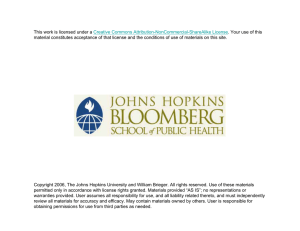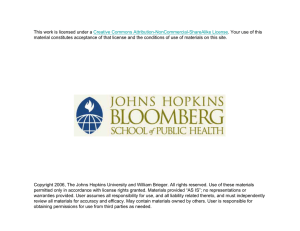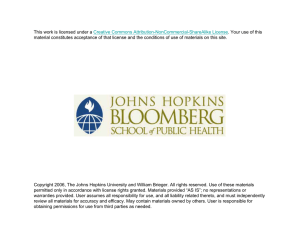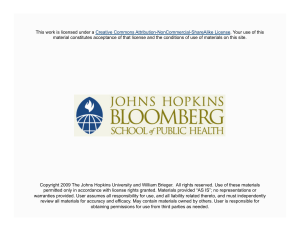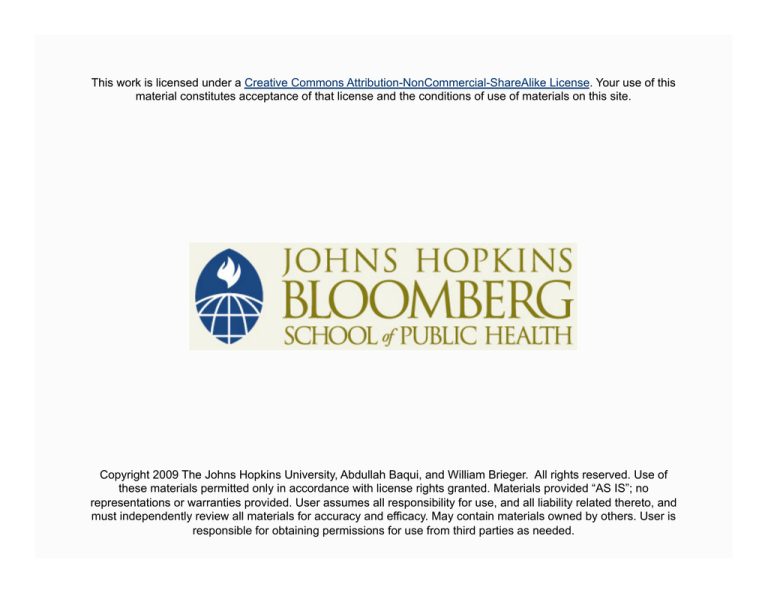
This work is licensed under a Creative Commons Attribution-NonCommercial-ShareAlike License. Your use of this
material constitutes acceptance of that license and the conditions of use of materials on this site.
Copyright 2009 The Johns Hopkins University, Abdullah Baqui, and William Brieger. All rights reserved. Use of
these materials permitted only in accordance with license rights granted. Materials provided “AS IS”; no
representations or warranties provided. User assumes all responsibility for use, and all liability related thereto, and
must independently review all materials for accuracy and efficacy. May contain materials owned by others. User is
responsible for obtaining permissions for use from third parties as needed.
Urban Primary Health Care and Health Systems
Abdullah Baqui, DrPH, MPH, MBBS
William Brieger, MPH, CHES, DrPH
Johns Hopkins University
Section A
Historical and Current Context and the Importance of
Effective Planning for Primary Health Care
Session Outline
Section A
- The historical and current context of urban PHC
- Importance of effective planning for PHC
Section B
- Issues to consider in planning PHC
- Possible solutions
Urban areas are more often
known for tertiary and
specialist care than for
primary health care
Photo by William Brieger
4
Context: Coverage, Quality, Efficiency
Successful PHC models in
developing countries are largely
limited to rural areas
Health services in rural areas are
delivered through detailed
infrastructure developed by
ministries of health
There are issues of coverage,
quality, and efficiency with rural
health services as well
Photo by William Brieger
5
Context: Infrastructure, Provider Mix
Photo by William Brieger
Photo by William Brieger
Most urban areas do not have comparable infrastructures
Urban areas are characterized by a mix of providers offering various
health services
There may be government services, private for-profit providers,
informal providers, and a variety of NGO providers
6
Context: Multiple Providers
Multiple providers with little or no coordination …
- Create duplications and gaps in services
- Affect accessibility to and quality of services
- Increase inequity
Photo by William Brieger
Photo by William Brieger
7
Context: Private Sector
Photo by William Brieger
Photo by William Brieger
The private sector is the major
provider
- This sector, including informal
providers, is poorly regulated
and coordinated
- Sometimes the private sector is
better equipped
- It may also have less formally
trained staff
8
Private Providers’ Focus
Private providers …
- Focus on curative care
- Rarely engage in
preventive care
- Provide services that are
largely unregulated
- Contribute minimally to
improving the health of
the urban poor
Photo by William Brieger
9
Context—NGOs
NGOs fill the gaps, but their
services are selective and cover
limited geographic areas
NGOs, while being not-for-profit
organizations, rarely give free
health care
Photo by William Brieger
They do, on the other hand, have
adequate staff, equipment, and
supplies
Photo by William Brieger
10
Poverty and Financing Challenges
Urban poor have limited access to affordable critical health services
of acceptable quality
There are critical gaps in essential services, with important
consequences
Urban poor spend a disproportionate share of their income on poorquality health care, much of it from the private sector
Urban residents largely work in
the informal economy and face
poverty daily
Photo by William Brieger
11
A Challenge to Improve
Improving the health of developing country urban populations is a
major challenge
There are many examples of urban health care delivery
- However, most urban models have been limited to small, pilot
areas
- Often emphasize the role of NGOs in coordinating and providing
service delivery
- Rarely capitalize on the important private sector
12
Infrastructure Challenges
Absence of government infrastructure may be an opportunity to
plan and design more innovative strategies
Governments have a responsibility to ensure access to a minimum
package of affordable and quality health care, particularly for the
poor
Governments do not necessarily need to provide the services
Clean water is a major urban
infrastructural challenge for people
and health facilities
Photo by William Brieger
13
Role of Government
Governments should take the stewardship role to ensure delivery of a
package of essential services
- Perhaps through optimization of existing services
- Creating incentives to ensure delivery of an appropriate mix of
services
- Regulating services to ensure affordability and quality
14
Importance of Effective Planning
Governments need to decide exactly what are the responsibilities of
the state in public health
- At the same time there needs to be acknowledgement of other
health sectors
- Regulatory and coordination mechanisms are needed to ensure
a system-wide approach to urban PHC
Planners need to examine what minimum package of essential
services is appropriate and how to deliver it
The complexity of the existing pattern of provision and financing
means that planning cannot be prescriptive
15
The Importance of Planning
Managers need to take into account …
- The current mix of services
- The relationships between different established organizations,
between different providers
- Current utilization patterns
- The quality of current services and gaps in services
Planning needs to be based on a careful situation analysis or needs
assessment
16
Possible Solutions?
At the city level, there is a need for a comprehensive assessment of
current provision and a formulation of a health service strategy
This may be done by the ministry of health or by the municipality
The starting point for the planning process is to identify guiding
principles
If these are not explicit, they need to be drafted
Source: Gordon et al. (1990).
17
Addressing Access
For example, is the guiding principle equity of access or ensuring a
simple, basic minimum package of health care that is accessible to
all?
A crucial element of planning is the purpose of the agency. For
example, is the municipality to …
- Provide appropriate and affordable health services for all
citizens?
- Provide for the poor?
- Facilitate quality private service provision for higher-income
groups?
18
Internal and External Environment
The planners need to assess the internal environment with respect
to available resources, e.g., staff, money, and infrastructure
The planners should also evaluate the external environment,
including …
- The current national policy with respect to direct provision of
services compared with promoting or regulating the private
sector
- The direction of decentralization
- National policy for health sector financing
-
-
National norms for setting service standards
The level of flexibility the municipality has in interpreting these
policies
19
Information Needs for Planning
The information should provide a sufficient basis for a realistic
strategic plan, consisting of the goals of the organization, and broad
objectives by which these goals will be achieved
Finally, this process leads to a series of detailed plans based on
operational objectives that are formulated in the process of
deciding what is needed to pursue the strategic objectives
20
Summary
Health services in most rural areas of developing countries are
provided by the government
Most urban areas do not have a comparable government health
infrastructure
Urban areas are characterized by their multiplicity of providers,
including a large private sector
Therefore, design of urban health services delivery requires careful
needs assessment and planning on how to optimize existing services
21
Section B
Issues to Consider in Planning Primary Health Care, and
Possible Solutions
Session Outline
Issues to consider in planning urban PHC
Possible solutions to meeting urban PHC needs
Photo by William Brieger
23
Issues to Consider
Minimum package of essential services at primary care level
Collaboration and complementarities between public and private
sector
Community participation or involvement in urban PHC
Should governments target the poor or should they provide universal
health care?
24
Essential Service Package
Factors that are important in selecting the essential package of
services should be
- The size and distribution of the burden of health problems
affecting the population
- Relative cost-effectiveness of the interventions
- Resources available to design and deliver health care
25
Essential Service Package
Communicable diseases, including pneumonia, diarrhea, malaria,
HIV/AIDS, and tuberculosis continue to account for major burden of
disease in urban areas
However, non-communicable diseases like diabetes, hypertension,
and heart disease are becoming increasingly important
This epidemiological transition can be observed in most cities in
developing countries
In most circumstances, health services are not prepared for the
emerging chronic diseases
26
Essential Service Package
Design of the service package needs to consider …
- The epidemiologic transition
- How to create demand for the essential services
It should be noted that there is no universally accepted “gold
standard” for designing a basic package of services
Typically, the package of essential services consists of vaccination;
outpatient care for common illnesses, such as pneumonia, diarrhea,
and malaria; reproductive health care; ongoing care for certain
chronic conditions; and promotional activities
27
Essential Service Package
The package should link
promotion, prevention, and
treatment
Packaging should also identify
and coordinate required
technical, administrative, and
educational resources
Photo by William Brieger
28
New Components
The epidemiological transition has brought new health care needs
and demands which are not met by current packages
Treatment for chronic and mental illnesses is hardly ever provided
Identification of the scope, content, and quality of services
provided by primary care services remains a major challenge
Photo by William Brieger
29
Complementarities: Public and Private
In many cities, the private sector is the main provider of curative
care
This is typical in many Asian cities, where the main providers of
care, even in poor areas, are private practitioners
Many international agencies and governments are examining ways to
provide care through the private sector
However, it is more complicated than it first appears
30
Complementarities
The private sector is responsible for creating demand for curative
health care and is motivated by profit
Thus the objective of the state in ensuring health services to the
population is different from that of the private provider
This “principal-agent problem” requires structural adjustments to
ensure that the objective of the agent (in this case the private
providers) and the principal (in this case the state) are made more
compatible
This requires a complex mix of effective regulations and financial
incentives, many of which are not currently in place or only
partially working
31
Complementarities
The quality of care of private providers varies a lot, from very high
to very low
In low-income urban areas, the quality of care is often low
Photo by William Brieger
Photo by William Brieger
32
Prospects and Problems
While private providers are often
seen as a good way of reducing
direct state responsibility, there
are a number of problems …
- Private providers, driven by
market forces, may not
provide unprofitable services,
causing preventive care to be
neglected
- Private providers may not
operate to maximize operative
efficiency, and therefore over
provide services
- A purely market approach to
care provision compromises
equity of access to basic
services
Photo by William Brieger
33
Possible Ways to Deliver PHC
Just to reiterate, we need effective planning
The first step to planning is for governments to decide what their
principles and objectives are
Many governments may consider that their responsibility in health
services is to ensure the availability of services at the primary and
secondary levels
Since private providers are well established in cities, enabling
private care to expand is relatively easy and should be cost
efficient, but regulating the private sector is difficult
34
Why Regulate?
Any consumer product requires some regulation to ensure consumer
safety
There are fundamental differences between health services and
many other products
- First, health care is important, as it relieves suffering
- Second, health care can be dangerous if inappropriate therapies
are given or care is not provided properly
35
Basic Standards
Governments have a responsibility to ensure a minimum quality of
care
This requires minimum basic care standards, packages of activities,
and coverage including maximum fee for services
Photo by William Brieger
36
How to Regulate the Private Sector?
Regulations require legislation, implementation procedures,
information systems, monitoring mechanisms, and effective and
rapid procedures for enforcement
One area of further exploration is voluntary accreditation by the
government of private sector providers
The government may accredit facilities if they pass the various
criteria and inspections
This requires inspections for renewal
The advantage for the providers is that accreditation may increase
their market advantage
37
How to Involve the Private Sector?
Create incentives for private providers to provide a broader package
of care—an example is the voucher scheme
Tanzania and Ghana evaluated the effectiveness of voucher schemes
to improve coverage of vulnerable groups with insecticide-treated
nets (ITNs)
Experience suggests that there are problems with both issuing and
redemption of vouchers
More evidence is needed on how specific contextual factors
influence the success of voucher schemes and other models of
delivery of ITNs
Rigorous monitoring is needed for successful scaling up
38
Community Participation in Urban PHC
The idea of community
participation in health first
appeared in the early 1970s as it
became clear that basic needs in
developing countries could be met
only through greater involvement
of local people themselves
Photo by William Brieger
39
Paying More Attention
From the 1980s onward, the
international donor community and
national governments began to pay
more attention to people’s
participation, along with good
governance, democracy, and
decentralization
Photo by Carrie Jane Ngogo
Photo by William Brieger
40
Value of Community Participation
It is believed that community participation increases efficiency and
encourages greater self-reliance and governance by handing over
decision making and control at the lowest level
Photo by William Brieger
41
What Is Community Participation?
The definition of both community and participation do vary
Participation can be defined as the actions taken by community
groups with shared needs living in a defined geographic area …
- In the identification of their needs
- In the decision-making process
- In the establishment and implementation of mechanisms to
meet these needs
There is a continuum of community participation, which can range
from contribution to decision making to involvement in service
delivery
42
Community Participation in Urban PHC
Experience with community participation in urban areas is limited
Since urban communities are different from rural communities, it
will be important to …
- Understand the urban communities
- Define what types of participation (and by whom) is feasible
and most cost-effective
Participation by ordinary citizens is determined by the balance
between benefits and costs
43
Benefits and Costs of Participation
Although benefits include collective goals, personal incentives and
personal costs are important factors
The intensity of participation varies inversely with the participating
group
The more intense the activity, the higher the cost to the
participants, which may result in less overall participation and the
overrepresentation of higher SES individuals
Exploring new and innovative ways of community participation in
urban PHC
44
Targeting the Poor and Vulnerable
To tailor urban PHC to the poor and vulnerable, innovative
approaches and ideas will be needed
Effective and efficient ways of identifying the poor can be a
challenge
In resource-poor settings, governments could earmark available
resources to the most needy through appropriate financing,
payment, and delivery mechanisms (e.g., a voucher system, microinsurance, contractual agreements)
45
Summary
Discussed issues to consider and possible solutions
Design of a minimum package of essential services should take into
account the epidemiological transition
Explore ways to improve collaboration and complementarities
between public and private sector
Community participation is important, but the scope and trade-offs
need to be carefully evaluated
Governments perhaps should provide a safety net for the poor
instead of providing health care for all
46

